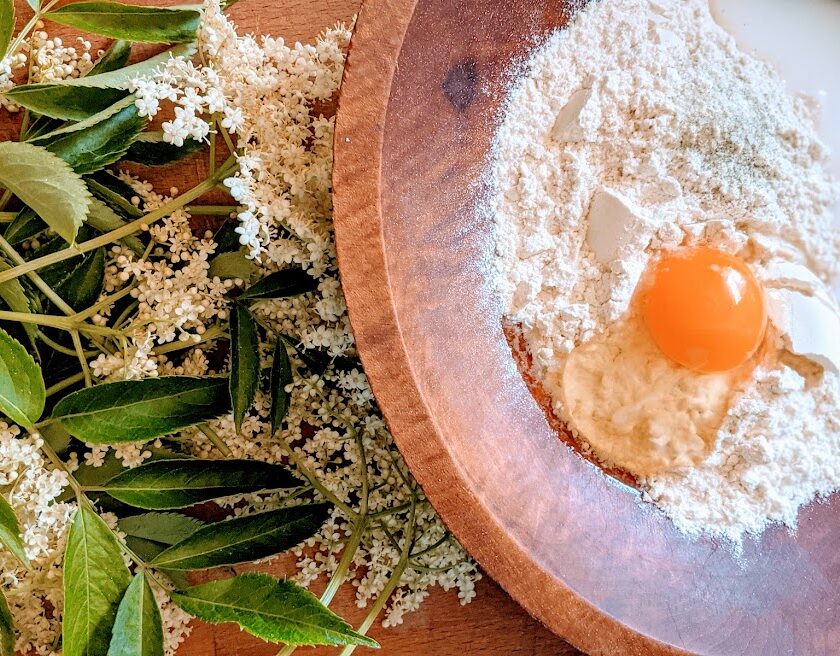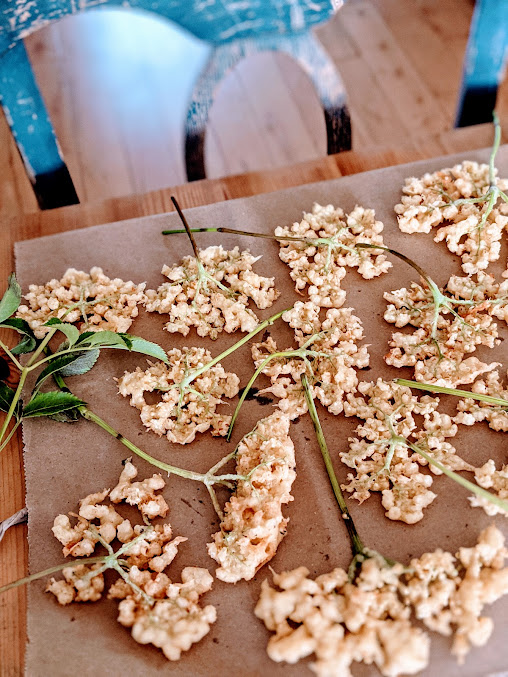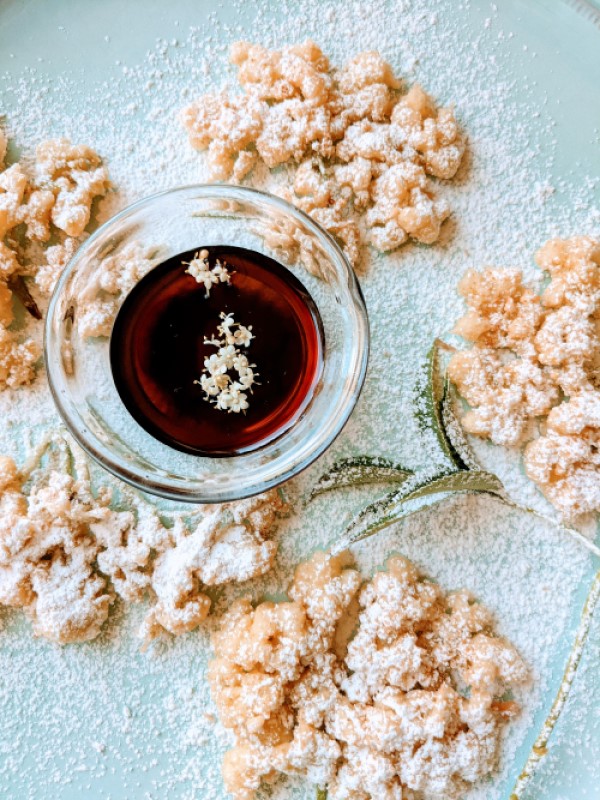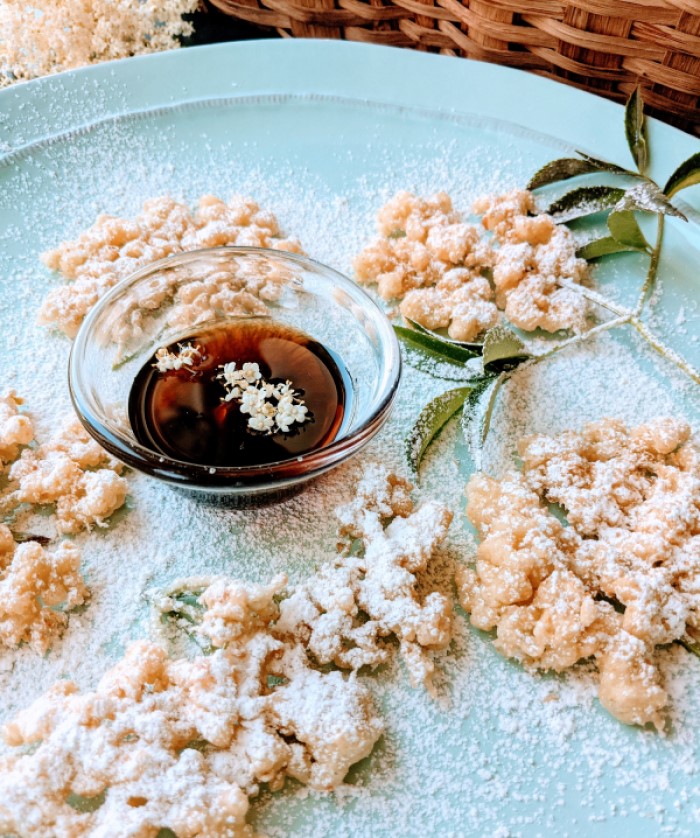Black Elderflower Fritters
By Alison Steele
The first flower I ever tasted was a honeysuckle blossom. Honeysuckle grows all over the hot rainy south in the summertime. It crawls along split rail fences, creeps up in the trees, and across old barns. My brother and I would spend hours following rivers over pasture and along railroad tracks, across bridges and through the mountains. A pocketful of honeysuckle went a long way when you got a little too far from home. It was more than likely my brother who taught me to eat honeysuckle and my older sister who taught him.
Bjorn remembers very clearly that his first was borage…blue stars with hints of cucumber and chestnut. His chubby dexterous fingers knew how to pinch only the tips of the flower to avoid getting poked by the whiskers. He said they just tasted good so he knew he could eat them. I vividly remember Viola’s were Pineapple Guava petals. I lost her for about an hour one hot summer day. After what seemed like an eternity, I discovered her way back in the chicken pen, in the shade of the feijoa, picking and eating the sweet tart petals.
I started eating flowers professionally when I went to work for a fiery Latina chef at an herb farm in Virginia when I was 19. Collecting herbs and flowers for garden parties, I learned the subtleties of flower flavor. I fell in love with every crack and crevice of that old farm and the two gentlemen who owned it. We worked from a renovated log cabin that was probably the first building there until the farmhouse was built in the late 1700s. The kitchen was bright and state-of-the-art, but the rest of the cabin was small and quaint. Punched tin lanterns revealed handmade furniture and calico quilts. There was a sleeping loft for overnight guests. One of the highlights there was assisting culinary educator and food writer, Susan Belsinger. Her book, Flowers in the Kitchen had just come out and she was touring. She taught us how to make fritters with elderflowers. It was simple and magical. I wondered if my mama had eaten them as a kid. Fried in lard and topped with wild mountain blueberries.
We buried my nephew this spring. At his graveside, friends and family old and new told stories and shared good memories. One friend shouted, “He taught me to eat flowers!” I smiled, and then cried. When it was all said and done, I managed to sing an a capella “Wildflowers,” and after many many hugs we all dispersed like elderflowers on a breezy summer day. If there is any legacy that I can pass on it’s this one. He would’ve been 40 this month. This one’s for you, sweet Preston.

Black Elderflower Fritters
20 small to medium elderflower heads with long stem attached
1 ¼ c unbleached all-purpose flour (a rice-based GF flour blend works beautifully)
1 ½ c milk (rice milk works, too)
1 fresh egg
Pinch of salt
Confectioner’s sugar for dusting
Maple syrup for dipping
Oil for frying
Small cast iron saucepan
Start the oil on medium high while whipping up the batter. Whisk together flour, most of the milk, egg, and salt until smooth. Add more milk as needed to thin out the batter. Lay out a couple of paper grocery bags next to the frying pot. Don’t be shy to experiment with a few flowers to get the heat and batter just right. Using the stem, fully coat the flowerhead with batter and allow it to drain off a bit on the edge of the bowl. Plunge it ever-so-slightly up and down into the hot oil and then let go. It’s fun and really fast! It only takes a minute or two for the perfect fry. When golden, pull it out slowly by the stem and place it on the brown bag. Two or three small heads should fit in the pot without overcrowding. Have tongs at the ready if the stem should fall into the oil. The floret should be taught and crisp, not drooping. Dust with confectioner’s sugar and dunk into warm maple syrup. Serve fritters hot and fresh!

~Tips~
Remember not to eat the stem or leaves. Only the flowers and berries are the edible parts of the elder. Sambucus nigra has bluish black berries, whereas its toxic cousin, Sambucus racemosa, has red. I’ve seen both on my forages. Know your elders!
When gathering elderflowers be sure to collect the ones that are fresh and just opening.
If using large heads, cut them in half or thirds and use a slotted spoon to fish them out of the hot oil, so they can be enjoyed in all their crispy glory.
Turn oil down to medium partway through. I use avocado oil when in California and peanut oil in Virginia. The elderflowers come a bit later in Virginia, so my harvest season for this plant is twice as long.
A rice based Gluten-Free all-purpose flour blend gives an extra crispy tempura texture.
This one is fun to make with kids, but teach them about hot oil and cast iron skillets first. Batter mixers, sugar dusters, and taste testers needed!

A native of Virginia, Alison Steele lives with her husband, two children, and cat in Boulder Creek where she raises quail, chickens, fruit trees, vegetables, and herbs. Alison plays banjo and sings in Sugar by the Pound.
Photos by Alison Steele
The San Lorenzo Valley Post is your essential guide to life in the Santa Cruz Mountains. We're dedicated to delivering the latest news, events, and stories that matter to our community. From local government to schools, from environmental issues to the arts, we're committed to providing comprehensive and unbiased coverage. We believe in the power of community journalism and strive to be a platform for diverse voices.





